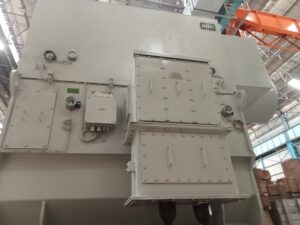Measuring the vibration of a three-phase induction motor is essential for predictive maintenance and ensuring the motor’s health and efficiency. Excessive vibration can indicate issues such as misalignment, imbalance, worn bearings, or other mechanical problems. Vibration measurement involves using specialized equipment, such as vibration sensors and analyzers.

Here’s a detailed explanation of how you can measure the vibration of a three-phase induction motor:
1. Select the Vibration Sensor:
- For motor vibration analysis, accelerometers are commonly used sensors. They measure acceleration in various directions, which can be converted to velocity or displacement data.
- Magnetic base accelerometers are often used for temporary measurements, while permanently mounted sensors are suitable for continuous monitoring.
2. Mount the Sensor:
- Mount the vibration sensor at a location on the motor where vibrations are most likely to occur. Common mounting points include near the motor’s bearings or on its housing.
- Ensure that the sensor is securely attached and aligned properly with the motor’s axis.
3. Collect Vibration Data:
- Connect the accelerometer to a data collector or vibration analyzer. This device will capture and process vibration data.
- Start the motor and collect data while it is running under normal operating conditions. Data collection may take place over a specified time period.
- Data should be collected in all three axes (X, Y, and Z) to assess vibration in different directions.
4. Analyze the Data:
- Once the data is collected, it needs to be analyzed using specialized software or equipment. Common parameters to analyze include:
- Amplitude: The magnitude of vibration, usually measured in units like mm/s (millimeters per second) or g (gravity).
- Frequency Spectrum: Analysis of vibration frequencies can help identify specific issues. For example, bearing faults often produce characteristic frequency peaks.
- Time Waveform: A graphical representation of vibration data over time can reveal transient events or irregularities.
5. Interpret the Results:
- The analysis results will provide insights into the motor’s condition. Common issues identified through vibration analysis include unbalance, misalignment, bearing wear, rotor issues, and resonance.
- The severity of the issue may be indicated by the amplitude of vibration and its frequency.
6. Take Corrective Actions:
- Based on the analysis results, take corrective actions to address any identified problems. This might involve realigning the motor, replacing bearings, or balancing the rotor.
- Regularly monitor the motor’s vibration levels to ensure that the issues have been resolved and that new problems are not emerging.
7. Maintenance Planning:
- Use the vibration data to plan maintenance activities. Regular monitoring and trend analysis can help prevent motor failures and extend their lifespan.
Vibration analysis is a crucial part of predictive maintenance in industrial settings, and it allows engineers to detect and address motor problems before they lead to costly downtime or equipment failure. Properly measuring and interpreting vibration data requires training and experience, so many organizations rely on skilled vibration analysts or maintenance professionals with expertise in this field.